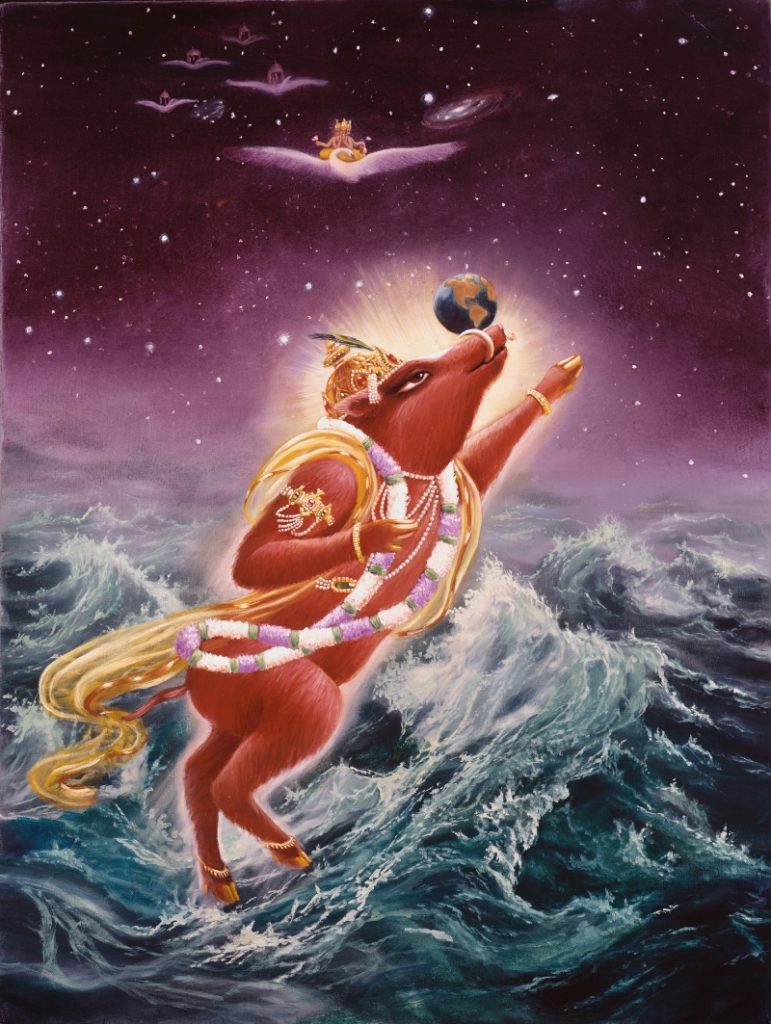The Srimad Bhagavatam describes the appearance of two different incarnations of Varahadeva, one white and another red, that came at different times. However, in the Srimad Bhagavatam, the pastimes of both Varahas are amalgamated in the same pastime, which makes it a little hard to understand.
On SB 3.13.31 Srila Prabhupada mentions that “According to Śrīla Jīva Gosvāmī, the Vedic literature describe the incarnation of Lord Varāha (Boar) in two different devastations, namely the Cākṣuṣa devastation and the Svāyambhuva devastation. This particular appearance of the boar incarnation actually took place in the Svāyambhuva devastation, when all planets other than the higher ones – Jana, Mahar, and Satya – merged in the water of devastation. This particular incarnation of the boar was seen by the inhabitants of the planets mentioned above. Śrīla Viśvanātha Cakravartī suggests that the sage Maitreya amalgamated both the boar incarnations in different devastations and summarized them in his description to Vidura.”

In the Srimad Bhagavatam (as well as in other Puranas) the emphasis is on the pastimes and the lessons we learn from them, and not on chronological order. Sometimes, pastimes that happened over a very long span of time are amalgamated with pastimes that happened recently (in the cosmic scale of time). For example, in the third canto, the story of Brahma becoming attracted to his daughter is spoken in connection with the story of the current cycle of creation, at the beginning of the current day of Brahma. The story of Brahma becoming attracted to his daughter however is something that happened a very long time ago, when Brahma was younger, before he became self-realized by hearing the song of the flute of Krsna.
We are currently on the first day after Brahma’s 50th birthday, so if we do the math, calculating the time based on the days and years of Brahma, we come to the conclusion that he is already alive for more than 155 trillion years. In other words, this is a story that happened many trillions of years ago. Taking this into consideration, it’s not a surprise that the pastimes of the two appearances of Varahadeva were condensed into just one.
Both stories happened in the current day of Brahma. The story of the first Varaha, the white Varaha, happened in the Manvantara of Svayabhuva Manu. There are 14 manus on each day of Brahma, and Svāyambhuva Manu is the first. In other words, this happened right at the beginning of the day of Brahma, when he was starting the creation.
At this point, Brahma had produced a number of sons, but most of them were renounced sages who were not interested in producing progeny. After deliberating about the situation, Brahma produced a couple: Svāyambhuva Manu and his wife Śatarūpā, who gladly accepted the mission of populating the universe. All human beings, as well as inhabitants of other planets, are descendants of Svāyambhuva Manu, and that’s why the is called the father of humankind.
However, Svāyambhuva Manu noticed that Bhu-mandala, his place of activity was submerged in the waters of the Garbodaka-ocean. As Brahma taught how to lift it up, Lord Varaha appeared from his nostrils, in a very small form that quickly grew in size and put Bhu-Mandala back in its place. This is the white Varaha. In this pastime He just lifted the whole Bhu-Mandala, there was no fight with Hiranyaksa. Because of the appearance of Lord Varahadeva in his white form, the reign of Svāyambhuva Manu is also called the Śveta-varāha millennium. Śveta-varāha means “white Varaha”
Lord Varaha appeared for a second time during the reign of Cākṣuṣa Manu, who is the 6th Manu in the sequence. Each Manu reign for a total of 306,720 million years, so there is a gap of at least 1.533 billion years between the two appearances of Sri Varahadeva. On SB 3.13.16p, Srila Prabhupada mentions: “According to Jīva Gosvāmī, the topics delineated here are of different millenniums. The present topics are of the Śveta-varāha millennium, and topics regarding the Cākṣuṣa millennium will also be discussed in this chapter.”
Srila Prabhupada uses the word millennium in different senses throughout his purports. It is sometimes used in the sense of a Yuga, a Divya-yuga (the combination of four yugas), a Manvantara (the reign of a Manu), a Kalpa (a day of Brahma), or even a Maha-Kalpa (the whole life of Brahma). In this case, Srila Prabhupada is using the word in the sense of a manvantara, or the reign of a particular Manu, not in the sense of a day of Brahma.
So, going back to the story, Lord Varaha appeared for the second time when Hiranyaksa caused the earth to fall into the Garbodaka-ocean by excessively mining it for Gold. Srila Prabhupada mentions on his purports that the planets are maintained in their orbits by a delicate balance of forces that can be disturbed by the excessive mining of natural resources. That’s definitely a warning for the human beings of our time.
Lord Varahadeva has a very special relationship with the Earth, which is considered his wife. Therefore, when the Earth fell into the Garbodaka ocean, the Lord appeared as lord Varahadeva to save her, and in the process killed Hiranyakasa by slapping Him with His lotus forefoot.
Srila Varahadeva is listed as a Lila-avatara, which suggests that He appears on each day of Brahma, just as Lord Krsna appears. In this way, just as in other incarnations of the Lord, His pastimes are unlimited. Thanks to the descriptions of Sukadeva Goswami we know about at least two of His appearances.
